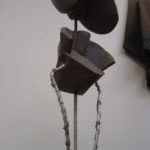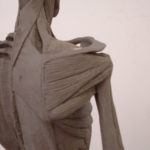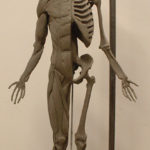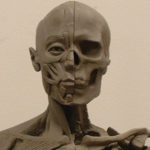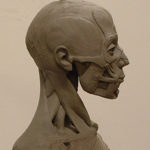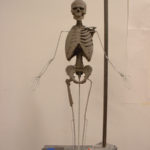
From there, skeletal features are sculpted... keep in mind that students are doing a number of drawings of these features in conjunction with the sculpture. I tell my students that the sculpture is second in importance to the drawings. I learned anatomy 2 dimensionally. You will only sculpt the flayed figure as good as you can draw.

Students are working from a number of free standing skeletons in the room as well as numerous free floating parts... i.e., a number of skulls, pelvis's, etc. Student's are encouraged to begin finding and purchasing their own. By the way, I have them begin with the skull because that head length will become their basic unit of measurement throughout.

2nd trimester... skeleton has already been blocked in and now muscles are added. I begin with the torso first and move out. Deepest muscles first then those that are most superficial. I don't get too deep.
I'm only concerned with those muscle that have a direct impact on the surface of the skin and create form. I'm not trying to be exhaustive with my anatomy students. My intent is to only focus on information that is useful to an artist. We are not medical students.
Students are encouraged to sculpt each individual muscle with in the proper order I set... always keeping in mind each individual muscle's shape, it's origin, and insertion.

More muscles. Check out the tube like form of the latissimus and the lateral form of the pectoralis as it creates the wall of the armpit. I was really trying to illustrate here how it's muscle fibers twist, one form lying on top of another as the pectoralis moves away from the sternum and eventually grabs onto the humerus.

Just beginning to lay in the trapezius. One side (left side) of the sculpture is left for the bones. That way students can refine their boney shapes as they work on the muscles. Studying the skeleton alone is not enough. All those bumps are there for a reason. Only by studying the muscles does one truly begin to appreciate the mechanics and the purpose of those individual bones.
 The thought behind designing the armature was so that the students could sculpt the skeleton without worries of the wire pushing through. It's very specific. Students will spend a week making this thing... the idea is that Écorché is a year long course. In other words, the student will be working on their sculpture for a whole year. If the armature is wrong in any way, it will only make problems for them in the future. The armature must be exact because it is also the student's only real 'truth'. The center rod serves as a centerline for the sculpture. So I am constantly encouraging students always to 'draw' on their sculpture and establish and re-establish their center line when it's lost (along the front, sides, and back).
The thought behind designing the armature was so that the students could sculpt the skeleton without worries of the wire pushing through. It's very specific. Students will spend a week making this thing... the idea is that Écorché is a year long course. In other words, the student will be working on their sculpture for a whole year. If the armature is wrong in any way, it will only make problems for them in the future. The armature must be exact because it is also the student's only real 'truth'. The center rod serves as a centerline for the sculpture. So I am constantly encouraging students always to 'draw' on their sculpture and establish and re-establish their center line when it's lost (along the front, sides, and back).

